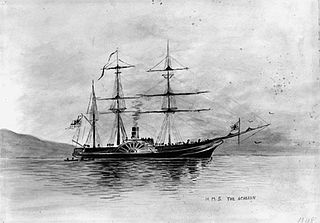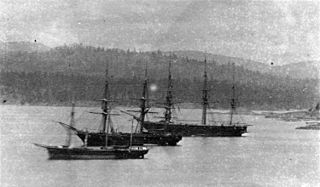
HMS Miranda was a 14-gun wooden screw sloop of the Royal Navy. As part of the 1847 Program, she was designed by John Fincham, Master Shipwright of Portsmouth ,and is considered an improved Rattler, with the design approved on 3 November 1847. She was ordered on 25 April 1847 with the name Grinder from Royal Dockyard, Sheerness. On 3 November 1847, she was reordered as Miranda from Sheerness Dockyard. Launched in 1851, she was completed to see action in the Crimean War. In 1854 she was in the White Sea and participated in the bombardment of the Port of Kola. She then served in the Sea of Azov during 1855. Two of her crew were awarded the Victoria Cross for their bravery. Towards the end of her career she transported troops during the New Zealand Wars. She was reclassified as a corvette by 1862. She was sold for breaking in December 1869.

HMS Acheron was the last Hermes-class wooden paddle sloop ordered for the Royal Navy. She was launched at Sheerness in 1838. She spent two commissions in the Mediterranean before being reclassed as a survey ship in 1847. Between 1848 and 1851 she made a coastal survey of New Zealand, the first such survey since Captain Cook. She was paid off at Sydney and was tender to HMS Calliope. She was sold at Sydney in 1855.

HMS Salamander was one of the initial steam powered vessels built for the Royal Navy. On 10 January 1831 the First Sea Lord gave orders that four paddle vessels be built to competitive designs. The vessels were to be powered by Maudslay, Son & Field steam engines, carry a schooner rig and mount one or two 10-inch shell guns. Initially classed simply as a steam vessel (SV), she was re-classed as a second-class steam sloop when that categorization was introduced on 31 May 1844. Designed by Joseph Seaton, the Master Shipwright of Sheerness, she was initially slated to be built in Portsmouth, and was changed to Sheerness Dockyard. She was launched and completed in 1832, took part in the Second Anglo-Burmese War and was broken up in 1883.

HMS Malacca was a 17-gun wooden sloop of the Royal Navy. She was ordered on 9 November 1847 from Moulmein, Burma to be built of teak. As a Surveyor's Department design, Malacca was based on the Conflict designed sloop which was approved on 9 December 1848. After launching in April 1853 she was commissioned the following month to be sailed to England for the fitting of her engine. She entered British Naval service in 1854 and served three commissions including action in the Russian War 1854 - 55 before being sold in 1869. Her resale to Japan, she served in the Japanese Navy as a training ship until broken in 1906.

HMS Hermes was a Hermes-class wooden paddle sloop of the Royal Navy. She was built at Portsmouth Dockyard. Initially she was used as apackey vessel until her guns were upgraded. She was re-engined and lengthened in 1842 to 43. She spent time on various stations in the Empire. She participated in the storming of Rangoon during the Second Burmese War. She was sold for breaking in October 1864.
Conflict was originally slated to be built to the Sampson designed steam vessel rated as a Steam Vessel First Class (SV1); however, the Admiralty, first rerated the vessels as First Class Sloops on 19 April 1845 then on 9 May 1845, she was ordered from a design of Sir William Symonds,Surveyor of the Navy. Originally designated as 10-gun vessels with 400 NHP engines. She served in the Baltic during the Russian war of 1854–55. She was sold for breaking in 1863.

HMS Desperate was originally slated to be built to the Sampson designed steam vessel rated as a Steam Vessel First Class (SV1); however, the Admiralty, first rerated the vessels as First Class Sloops on 19 April 1845 then on the 9 May 1845, she was ordered as First-Class screw sloops to be built from a design of Sir William Symonds, Surveyor of the Navy. She would be a 10-gun vessel with 400 NHP engines. She served in the Baltic during the Crimean war, and as a store ship to Edward Augustus Inglefield's Arctic expedition. She was broken up by 1865.
HMS Archer was initially ordered as one of two Rifleman type gunvessels on 25 April 1846. With her construction suspended in September 1846, she was reordered on as a sloop on 25 April 1847 to be constructed to a design of John Edye as approved on 25 August. With the exception of two years on Baltic service during the Russian War of 1854 to 1855 she spent the majority on the West Coast of Africa on the anti-slavery patrol. This service involved anti-slavery work on the coasts of the Bight of Benin, and was notoriously unhealthy, with tropical diseases taking a heavy toll of British seamen. One of her commanders died and three others were invalided. Archer was reclassified as a corvette in 1862. She finally returned to Home waters, being sold for breaking in January 1866

HMS Wasp was an Archer type sloop ordered on 25 April 1847 from Deptford Dockyard. Two references stipulate that Parthian, ordered with Archer the year prior was renamed Wasp when ordered as a sloop. However, Parthian remained on the books at Deptford, as a Rifleman type gunvessel until cancelled in June 1849. Therefore Wasp was a new build. She served on many different stations during her career, including West Coast of Africa, in the Mediterranean and Black Sea during the Russian War of 1854 - 55, on the South East Coast of America, Cape of Good Hope where she went aground twice and the East Indies before being sold for breaking in December 1869.
HMS Rhadamanthus was one of the initial steam powered vessels built for the Royal Navy. On 10 January 1831 the First Sea Lord gave orders that four paddle vessels be built to competitive designs. The vessels were to be powered by Maudslay, Son & Field steam engines, carry a schooner rig and mount one or two 10-inch shell guns. Initially classed simply as a steam vessel (SV), she was re-classed as a second-class steam sloop in 1846. Designed by Thomas Roberts, the Master Shipwright of Plymouth. She was launched and completed in 1832, She was converted into a transport in 1841 then in 1851 she was a troopship and by the 1860s she was a transport again. Her breaking was completed in February 1864.
HMS Medea was one of the initial steam-powered vessels built for the Royal Navy. On 10 January 1831 the new First Lord Sir James Graham, 2nd Baronet gave orders that four paddle vessels be built to competitive designs. The vessels were to be powered by Maudslay, Son & Field steam engines, carry a schooner rig and mount one or two 10-inch shell guns. Initially classed simply as a steam vessel (SV), she was re-classed as a second-class steam sloop when that categorization was introduced on 31 May 1844. Designed by Oliver Lang, the master shipwright of Woolwich. She was launched and completed in 1834, took part in the Syrian Coast Campaign and was broken up in 1867.
HMS Volcano was a Hermes-class wooden paddle sloop of the Royal Navy. She was built at Portsmouth Dockyard. She was launched in 1836. Her first few commissions were on packet service in the Mediterranean and North American and West Indies Stations and on the anti-slavery patrol on the West Coast of Africa. In 1854 she was converted to a factory ship and served in the Baltic during the Russian War. She was sent to China during the Second Opium War as a factory ship. On her return she was assigned to Portsmouth, on Harbour Service as a stationary factory ship. She remained there until sold for breaking in 1894.
HMS Stromboli was initially a Steam Vessel second class designed by Sir William Symonds, Surveyor of the Navy, and built at Portsmouth. She was commissioned and participated in the bombardment of Acre in 1840, during the Russian War she was used as a troop transport in the Baltic in 1854, she was in the Black Sea and the Sea of Azov in 1855. Her last overseas posting was on the South East Coast of America. She was sold for breaking in August 1866.
HMS Alecto was an Alecto-class sloop designed by Sir William Symonds, Surveyor of the Navy. Originally classed as a steam vessel (SV3), her classification would be changed to a Third Class Sloop. She initially served in the Mediterranean, prior to her tug of war with the Rattler. She spent her time in the Americas and mainly on the anti-slavery patrol off the west coast of Africa. She was broken in November 1865
HMS Prometheus was an Alecto-class sloop designed by Sir William Symonds, Surveyor of the Navy. Originally classed as a steam vessel (SV3), her classification would be changed to a Third Class Sloop. She initially served mainly on the west coast of Africa on the anti-slavery patrol except for a brief period on particular service in the Black Sea in late 1855. She was sold on 5 March 1863 for breaking.
HMS Polyphemus was an Alecto-class sloop designed by Sir William Symonds, Surveyor of the Navy. Originally classed as a steam vessel (SV3), her classification would be changed to a Third Class Sloop. She initially served in the Mediterranean, west coast of Africa and the Baltic. She was wrecked on the Baltic side Jutland on 29 January 1856.
HMS Inflexible was a Bulldog-class sloop designed by Sir William Symonds, Surveyor of the Navy. Originally she was ordered as a Driver-class sloop, however, under Admiralty Order of 26 December 1843 she was directed to be built to a new specification. After commissioning she sailed for the East Indies and participated in the last year of the New Zealand War of 1845 to 1847. She then was in the Black Sea for the Russian War followed by the Second Opium War with China. She was sold for breaking in July 1864.
HMS Scourge was a Bulldog-class sloop designed by Sir William Symonds, Surveyor of the Navy. Originally she was ordered as a Driver-class sloop, however, under Admiralty Order of 26 December 1843 she was directed to be built to a new specification. She was initially commissioned for service with the Channel Squadron before moving to the North America and West Indies Station. She then served in the Mediterranean then the west coast of Africa. Her final service was in the Mediterranean. She was broken in 1865.

HMS Bulldog was a Bulldog-class sloop designed by Sir William Symonds, Surveyor of the Navy. Originally she was ordered as a Driver-class sloop, however, under Admiralty Order of 26 December 1843 she was directed to be built to a new specification. After commissioning she sailed for the Cape of Good Hope. She then was in the Baltic Sea for the Russian War. She carried out ocean sounding for the Atlantic telegraph. She was lost while in action with the Haitians in 1865.
HMS Fury was a Bulldog-class sloop designed by Sir William Symonds, Surveyor of the Navy. She was ordered on 19 February 1844. After commissioning she sailed for the East Indies and participated in action against pirate junks near Vietnam. She then was in the Black Sea for the Crimean War followed by the Second Opium War with China. She was sold for breaking in July 1864.









